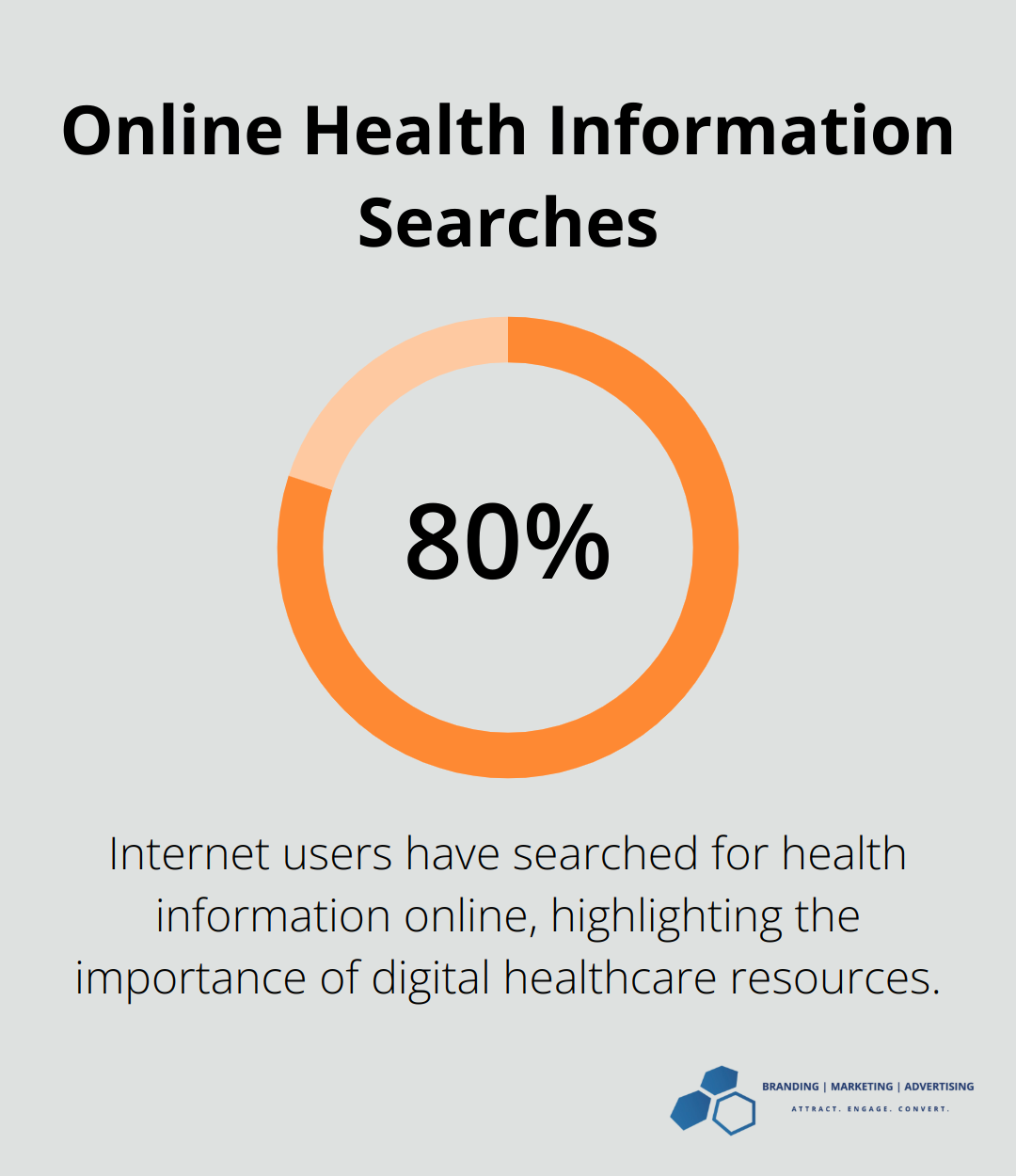How to Master Strategic Health Care Marketing
At Branding | Marketing | Advertising, we’ve seen firsthand how strategic healthcare marketing can transform medical practices and institutions.
The healthcare landscape is rapidly evolving, and marketers must adapt to stay ahead. This blog post will guide you through the essentials of mastering strategic healthcare marketing.
We’ll explore current trends, unique challenges, and effective tactics to help you create patient-centered strategies that drive results.
What’s Shaping Healthcare Marketing Today?
The healthcare marketing landscape transforms rapidly. Several key trends reshape how healthcare providers connect with patients.
Digital-First Patient Engagement
Today’s patients expect seamless digital experiences. Digital-First Patient Engagement has become increasingly important, especially during the COVID-19 pandemic. For example, telehealth effectively mitigated the impact on cancer care, with 54.1% of patients at an academic cancer center using these services.

Healthcare marketers must prioritize digital channels to meet these expectations. This includes:
- Optimizing websites for mobile devices
- Implementing user-friendly online appointment booking systems
- Leveraging social media for patient engagement
Mayo Clinic, for example, has successfully used TikTok to share health information, garnering millions of views and increasing brand awareness among younger demographics.
Data-Driven Personalization
Personalization is no longer a luxury-it’s a necessity. Healthcare marketers increasingly use data analytics to tailor their messaging and services to individual patient needs.
Implementing personalized marketing strategies requires a robust data infrastructure and adherence to strict privacy regulations. Aetna’s use of AI-powered personalized video experiences improved their Net Promoter Score and reduced call center inquiries.
Content Marketing for Patient Education
With patients actively seeking health information online, content marketing has become a critical tool for healthcare providers.
Effective content marketing in healthcare focuses on providing valuable, accurate health information that addresses patient concerns and builds trust. Cleveland Clinic’s Health Essentials blog attracts over 7 million visitors monthly with its expert-written health content.
Navigating Unique Challenges
Healthcare marketers face distinct challenges, particularly in navigating strict regulatory environments while striving for innovation. HIPAA compliance, for instance, limits the use of patient data for marketing purposes. This requires marketers to innovate in their approach to personalization and targeting.
Another significant challenge is building and maintaining trust. In an era of misinformation, healthcare providers must position themselves as reliable sources of health information. This necessitates a commitment to transparency, accuracy, and ethical marketing practices.
Patient-Centered Approach
The key to mastering healthcare marketing lies in adopting a patient-centered approach. This means understanding patient needs, preferences, and behaviors at every touchpoint of their healthcare journey. By aligning marketing strategies with patient expectations, healthcare providers can improve patient satisfaction, loyalty, and ultimately, health outcomes.
Creating marketing strategies that put patients first involves conducting thorough patient research, developing detailed patient personas, and tailoring marketing messages to address specific patient concerns and motivations.
As we move forward, it’s clear that healthcare marketing will continue to evolve. The next section will explore how to develop a comprehensive healthcare marketing strategy that addresses these trends and challenges while keeping patients at the center of all efforts.
How to Create a Winning Healthcare Marketing Strategy
At Branding | Marketing | Advertising, we understand that developing a comprehensive healthcare marketing strategy is essential for success in today’s competitive landscape. Let’s explore the key components of an effective strategy that will set your healthcare organization apart.
Know Your Audience Inside and Out
The foundation of any successful marketing strategy is a deep understanding of your target audience. In healthcare, this means creating patient personas that go beyond basic demographics. You should conduct thorough research to uncover your patients’ needs, fears, and motivations. This process involves researching target patient populations, determining preferred communication methods, and building out detailed personas.
A pediatric clinic might create personas for different types of parents, such as first-time parents, working parents, or parents of children with chronic conditions. Each group has unique concerns and preferences that should inform your marketing approach.
Set SMART Marketing Objectives
Your marketing objectives should be Specific, Measurable, Achievable, Relevant, and Time-bound (SMART). Align these objectives with your organization’s overall goals. For instance, if your goal is to increase patient volume for a new cardiac care unit, a SMART objective might be: “Increase new patient appointments for cardiac services by 25% within the next six months.”
You should track your progress regularly using key performance indicators (KPIs) such as website traffic, appointment bookings, or patient satisfaction scores. Adjust your strategy as needed based on these metrics.
Craft Compelling Messages That Connect
Healthcare marketing messages should strike a balance between professionalism and empathy. Focus on the benefits your services provide rather than just listing features. Address common patient concerns and highlight what sets your organization apart.
Consider using patient stories to illustrate the impact of your care. Mayo Clinic’s “You Know Where to Go” campaign featured real patient testimonials, effectively showcasing their expertise while building emotional connections with potential patients.
You should tailor your messaging to different audience segments and platforms. The tone and content you use on Instagram might differ from what you use in email newsletters or print ads.
Choose the Right Marketing Channels
Selecting the appropriate marketing channels is important for reaching your target audience effectively. While digital channels are increasingly important, don’t neglect traditional methods that may still resonate with certain patient groups.
Consider these channel options:
- Website and SEO: Optimize your website for search engines and user experience. A study by Pew Research Center found that 80% of internet users have searched for health information online.

- Social Media: Platforms like Facebook, Instagram, and LinkedIn can help you engage with patients and share valuable health information. Johns Hopkins Medicine uses Twitter to share health tips and research findings, reaching over 480,000 followers.
- Email Marketing: Use targeted email campaigns for patient education, appointment reminders, and health tips. Personalize content based on patient data and preferences.
- Content Marketing: Create informative blog posts, videos, and infographics to establish your organization as a trusted health resource. Cleveland Clinic’s Health Essentials blog attracts millions of readers monthly with its expert-written content.
- Paid Advertising: Use targeted ads on search engines and social media platforms to reach specific patient groups. Google Ads can be particularly effective for capturing high-intent searches for healthcare services.
- Community Outreach: Participate in local health fairs, sponsor community events, or offer free health screenings to build brand awareness and trust.
You should integrate your marketing efforts across channels for a cohesive patient experience. Use analytics tools to measure the performance of each channel and adjust your strategy accordingly.
Now that we’ve outlined the key components of a winning healthcare marketing strategy, let’s explore specific tactics you can use to implement your strategy effectively.
Proven Tactics to Elevate Your Healthcare Marketing
At Branding | Marketing | Advertising, we have identified key tactics that can significantly boost your healthcare marketing efforts. Let’s explore these strategies and how you can implement them effectively.
Content Marketing: The Cornerstone of Patient Education
Content marketing serves as a powerful tool for educating and engaging patients. Create a content calendar that focuses on topics addressing common patient concerns and questions. For example, a cardiology practice might produce articles on heart-healthy diets, exercise tips, and explanations of common procedures.
Mayo Clinic’s blog receives over 7 million monthly visitors by providing expert-written, easy-to-understand health content. To replicate this success, focus on creating high-quality, SEO-optimized content that provides real value to your audience.
Consider diversifying your content types. While blog posts are important, don’t overlook the power of video content. According to a recent study, video is used by 89% of businesses and is considered integral to the marketing strategy of 95% of marketers – an all-time high.
Harnessing Social Media for Trust and Community Building
Social media platforms offer unique opportunities to build trust and foster community engagement. Johns Hopkins Medicine effectively uses Twitter to share health tips and research findings, reaching over 480,000 followers.
To maximize your social media impact:
- Choose platforms where your target audience is most active
- Share a mix of educational content, patient stories, and behind-the-scenes glimpses of your practice
- Engage with followers by responding to comments and messages promptly
- Use social listening tools to monitor conversations about your brand and industry
Consistency is key in social media marketing. Try to post regularly and maintain a consistent brand voice across all platforms.
Website Optimization: Your Digital Front Door
Your website often serves as the first point of contact between your practice and potential patients. Optimize it for both user experience and conversions. A Google study found that 53% of mobile site visitors leave a page that takes longer than three seconds to load.
To improve your website’s performance:
- Ensure fast loading times across all devices
- Implement a responsive design for seamless mobile viewing
- Use clear calls-to-action (CTAs) to guide visitors towards booking appointments or contacting your practice
- Include patient testimonials and success stories to build trust
- Optimize your site for local SEO to improve visibility in local search results
Email Marketing: Nurturing Patient Relationships
Email marketing remains a highly effective tool for patient retention and engagement. Personalize your email campaigns based on patient data and preferences. For instance, send appointment reminders, health tips tailored to specific conditions, or information about new services relevant to each patient’s needs.
A study by Campaign Monitor found that segmented email campaigns can lead to a 760% increase in revenue. Use this strategy to improve your email marketing effectiveness.
Telemedicine and Virtual Care: The Future of Healthcare Marketing
The COVID-19 pandemic accelerated the adoption of telemedicine, and this trend continues to grow. According to a 2023 McKinsey report, telehealth utilization has stabilized at levels 38 times higher than pre-pandemic baseline.

To effectively market your telemedicine services:
- Clearly communicate the benefits of virtual care on your website and social media channels
- Provide step-by-step guides on how to access and use your telemedicine platform
- Highlight the convenience and accessibility of virtual consultations in your marketing materials
- Offer virtual tours or demos of your telemedicine services to familiarize patients with the process
These tactics can help you create a comprehensive healthcare marketing strategy that engages patients, builds trust, and drives growth for your practice. The key to success lies in consistently delivering value to your patients across all touchpoints.
Final Thoughts
Strategic healthcare marketing demands constant adaptation and innovation. Healthcare providers must understand the current landscape, develop comprehensive strategies, and implement effective tactics. Patient-centered marketing efforts create detailed personas, set clear objectives, craft compelling messages, and choose the right channels to resonate with target audiences.
The healthcare industry evolves rapidly, necessitating regular updates to marketing approaches. Providers should stay informed about emerging trends, technologies, and patient preferences. Regular analysis of marketing performance allows for data-driven adjustments to strategies (ensuring optimal results).
At Branding | Marketing | Advertising, we help healthcare providers navigate digital marketing complexities. Our experts can develop and implement a tailored strategic healthcare marketing plan for your specific needs and goals. Take the next step to elevate your healthcare marketing efforts and position your organization as a trusted provider in your community.












